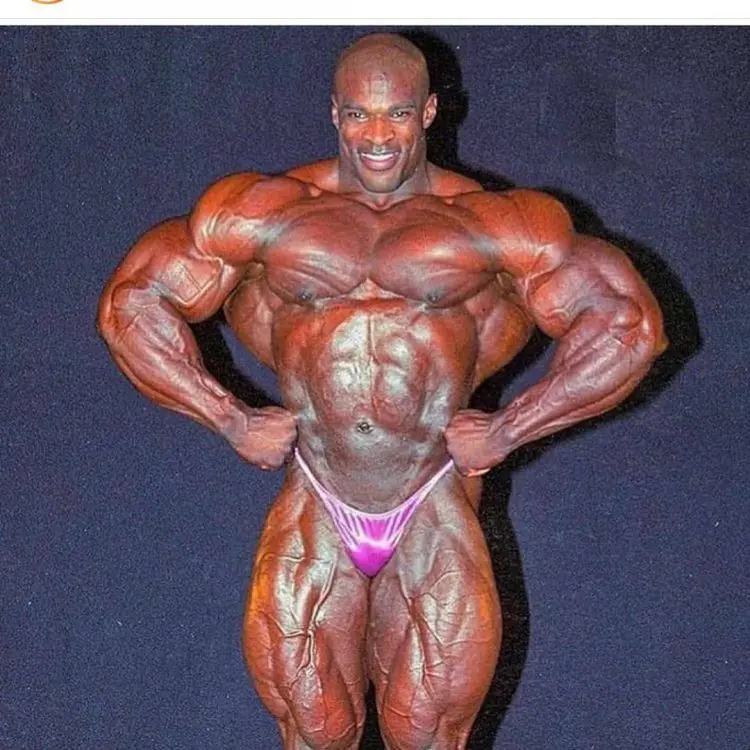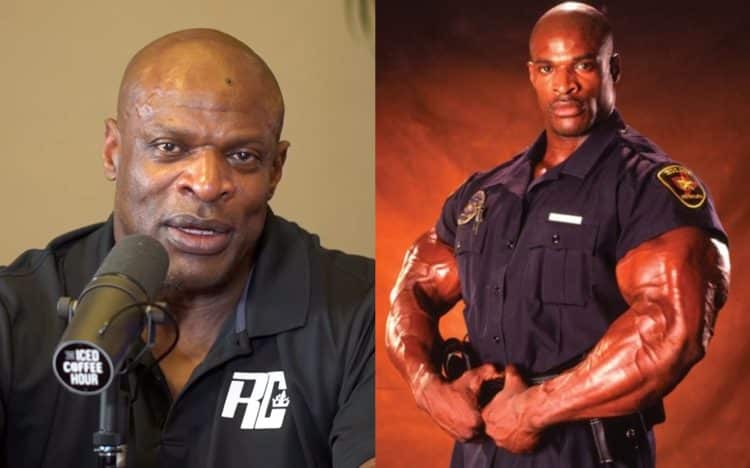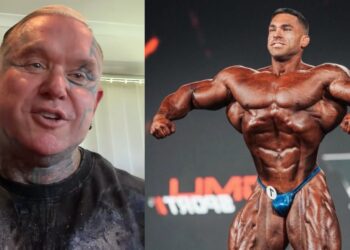Despite a busy schedule, Ronnie Coleman remains in love with bodybuilding. In a recent interview on the Iced Coffee Hour YouTube channel, Coleman discussed his career earnings and tackled an array of topics related to his time in the sport.
In 1998, Ronnie Coleman seized the Mr. Olympia throne in the wake of six-time champion Dorian Yates‘ retirement. At the contest, he defeated a prime Flex Wheeler and Nasser El Sonbaty on his way to capturing the throne. Coleman welcomed the pressure in the years that followed and ultimately secured eight Mr. Olympia victories until his nemesis, Jay Cutler, took the title from him in 2006.
“The King’s” last competition came in 2007 at Mr. Olympia in fourth place. Having stepped away from the stage, he remains committed to seeing the sport thrive. However, his illustrious career was not without its sacrifices. He’s admitted to undergoing over ten back surgeries, which have ultimately compromised his ability to walk without assistance.

Coleman has seen the sport change drastically since his time on stage. From financial incentives to stem cell treatments, he’s doing all he can to ensure longevity following a near-decade of intense battles against some of the sport’s best.
Ronnie Coleman Talks Career Earnings, Banking $750,000 on Cameo, & Body Dysmorphia
According to Coleman, the prize money for winning Mr. Olympia ‘was nothing.’ Instead, he said most of his earnings came from endorsement deals as a result of his performances. He also had clothing, supplement, and shoe contracts for additional income. Overall, Coleman said he was making ‘millions’ per year during the height of his career.
“The biggest thing I got from winning the Olympia was the endorsement. The prize money for winning the Olympia – $100,000 that’s nothing,” Coleman laughs. “I did use that to pay off my house. But the big money came from endorsements, you know. Other stuff that I did, like I had a supplement contract, clothing contract I had, shoe contract, so all the money – all the real money comes from endorsements.”
Get Fitter, FasterLevel Up Your Fitness: Join our 💪 strong community in Fitness Volt Newsletter. Get daily inspiration, expert-backed workouts, nutrition tips, the latest in strength sports, and the support you need to reach your goals. Subscribe for free!
“It was pretty close to a million dollars, yeah. Well, I won my first Olympia in 1998. Yeah. Of course, you know, I had quite a few endorsements though. Then, I had personal appearances that I was doing, so it was in the millions.”
Coleman shared that when he turns 60 next year he’ll qualify for his pension from when he served as a police officer.
“I saved a lot and put it into retirement. Like I said, getting a retirement check at the end of this year. From one of those and when I turned 60 next year, I get my police retirement. Social security, I put a lot of money into that also. I’ll be pretty much set for life.”
As far as work ethic is concerned, Coleman believes it was something he was simply born with.
“It was something that I was born with. I was always trying to be the best at everything that I was that I did. I was always challenging myself to be the best at everything. That’s what I did because being the best, the rewards were great. I always challenged myself. Everything that I did. Everything. Even if I was playing a pick-up game of cards.”
Coleman highlighted that the majority of his income came from special appearances when he competed actively.
“Man there were times when I would leave my house for three months and let’s see, there’s 365 days in a year, right? So out of those 365 days right, I was gone 300 days, just doing appearances,” said Coleman. “Let’s say it like this: if it wasn’t worth it, I wouldn’t be doing it. It was definitely worth it, for sure.”
Currently, the former eight-time Mr. Olympia is making $750,000 a year using apps like Cameo Online.
“$750,000 a year doing Cameo? asks the interviewer.
“I have about ten of those things holding right now. I was doing them up in my room before I came down here. Oh, man. Sometimes, I can get ten a day. $300 [each]. It adds up. It don’t take that long to do it. How long does it take to say happy birthday or happy anniversary.”
When asked about the success of his supplement company Ronnie Coleman’s Signature Series, the 59-year-old said the following:
“We’re in our 12th or 13th year, [in the supplement market],” said Coleman. “I started with supplements back in 1994 I think I had my first contract. I was with two or three different other companies. I saw the profit they were making. I’m like man, hm, if I’m making them this kind of money, what kind of money can i make myself if I got into it? And that’s how I got into it.”
Switching gears, Coleman opened up on the prevalence of body dysmorphia in bodybuilding, which he says has gotten worse recently.
“I would say so [every bodybuilder has body dysmorphia]. I would say so for sure,” shared Coleman. “Yeah, it’s changing for sure because of social media. It’s a lot worse now than when I was doing it. There’s so much more criticism. So much criticism.”
His advice for younger bodybuilders is to retain as much knowledge about the sport as possible.
“Going to the gym and eating a real healthy diet. The best advice I can give somebody is what I’ve learned: bodybuilding is all about knowledge and the more you have the better off you’re going to be,” said Coleman.
Instead of seeking to gain size, Coleman said that younger competitors should focus on the fundamentals of bodybuilding.
“It’s about shape and symmetry, and condition. I guess I didn’t have enough condition at the size I was.”
“I was told that one year [that I was too big]. One of the judges. The one time I listened to a judge and I was l like okay, I’ll never do that again. The next year I came in, they said I was too small. I was like okay, I’m just going to start taking my own advice like I’ve always done and do what I want to do. That’s when I came in the heaviest ever at almost 300 pounds on stage.”
Coleman Touches on First Herniated Disc and Stem Cell Therapy: “Best Thing That’s Ever Happened to Me”
Coleman believes he herniated a disc in his back for the first time when he was squatting 600 pounds for reps.
“I had a high pain tolerance. Just made it [herniated disc] worse by continuing to do that I was doing,” said Coleman. “It was squatting [that herniated my discs]. I can remember it like it was yesterday. I was squatting 600, I do that all the time. I’ll do 12-15 reps. This day I coming for rep number eight and I heard a loud bang. It was so loud it kind of hurt my ear.”
Given his injuries and mobility issues, Coleman began receiving stem cell therapy and says it’s brought significant improvements to his quality of life.
“I know for the last two years I’ve been getting stem cells and it’s been the best thing that’s ever happened to me in my life. Yeah, but you got to go out of this country to do it because they don’t really allow the real stem cells that comes from the placenta you know? They don’t allow that here in the United States because of politics for the most part. Pain people would lose too much money.”
‘It wipes out the pain,” added Coleman.”
This isn’t the former eight-time Mr. Olympia’s first stem cell treatment update. In an interview with Muscular Development’s Ron Harris, Coleman revealed that his pain had improved with the help of the new treatment. However, he shared that his walking is ‘about the same.’ Nevertheless, he’s optimistic about the future.
Despite his health struggles, Ronnie Coleman still inspires his fans with workouts today. His one-of-a-kind physique will always be his legacy, but Coleman also has a deep understanding of the business side of the sport.
RELATED: Every Winner of the Mr. Olympia Bodybuilding Competition









